Second Incident For DFDS Ro-Ro Ship
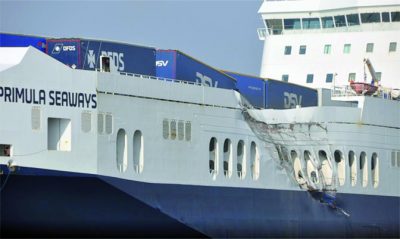
In the early hours of 3rd March the 61,870gt/2011 built containership MSC Madrid collided with the 37,985gt/2004 built Ro-Ro ship Primula Seaways while heading towards Antwerp, Belgium, from Hamburg. The collision occurred in the vicinity of Vlissingen, while the containership was inward bound from an anchorage and the Ro-Ro ship was outward bound for Brevik/Gothenburg from Ghent. The 5,500 TEU capacity containership appeared to turn towards the ferry and sustained damage to her bow while the Ro-Ro ship suffered a major bow-shaped blow to her port side. After the incident, the MSC Madrid continued her voyage to Antwerp, whilst the Primula Seaways (above) made her own way back to Ghent. An investigation is ongoing and the ferry will be repaired at the Fayard Shipyard at Odense. The Primula Seaways was previously involved in a collision with the car carrier City of Rotterdam on the River Humber on 3rd December 2015. After that mishap, the pilot and the captain of the car carrier both received suspended sentences of four months in prison, which was suspended to 18 months subsequently. To mitigate the effect of the incident on its customers, DFDS is leveraging the extensive route network and a larger ship from another route will be swapped with a ship on Gothenburg-Ghent. This will add capacity to Gothenburg-Ghent. In addition, the 15,375gt/1986 built Ro-Ro ship Maestro Sea has been chartered short-term and arrived in Gothenburg on 6th March. The 32,523gt/2004 built Petunia Seaways has joined the Ghent service from Immingham-Gothenburg with the 33,314gt /2014 built Ark Germania being moved from the Ghent route to Immingham-Gothenburg.
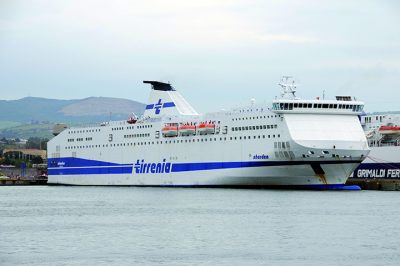
Around two weeks earlier, on 14th February, the 39,798gt/2005 built Tirennia ferry Sharden (above) hit a quayside at the port of Genoa, Italy whilst attempting to berth. The ship sustained a large gash in her hull just above the waterline, disembarked her passengers and vehicles and received attention in dry dock two days later. The following day the 14,398gt/1994 built Ro-Pax ferry Drujba collided with the 22,456gt/2012 built and 180m long bulk carrier Dvadesetprvi Maj at Bourgas, Bulgaria. The Drujba had arrived from Batumi when she struck the port side of the bulk carrier, which sustained damage to her deck equipment and hull.

New Order For Austal
Following the Memorandum of Understanding (MOU) announced on 8th December 2017, Austal announced on 5th March the award of a A$68 million contract to design and build an 83m trimaran ferry for JR Kyushu Jet Ferry of Japan. The trimaran, with a capacity for 502 passengers and an operational speed of 37 knots, will service JR Kyushu Jet Ferry’s key strategic route between Fukuoka, Japan and Busan, South Korea. The vessel will feature a customised interior, developed by respected Japanese design house, Don Design Associates. Construction of the vessel will commence in late 2018, with services scheduled to begin prior to the Summer Olympic Games in Tokyo in 2020.
Baleària Invests
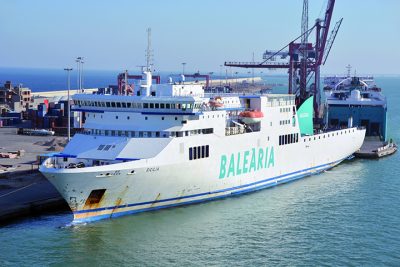
Mediterranean operator Baleària recently invested nearly €75 million to purchase three ships to reinforce its fleet. The shipping company purchased the 24,409gt/2002 built Visentini sisterships Nápoles and Sicilia (above) from Stena Ro-Ro plus the 5,989gt/1999 built fast ferry Jonathan Swift from Irish Ferries. Following these transactions, Baleària now owns 24 of the 25 vessels in its fleet. The two 2,000 lanemetre and 950 passenger capacity ferries were chartered in 2015 by the company and are being used for the València-Eivissa-Palma and Barcelona-Eivissa routes, respectively. Furthermore, two LNG powered ferries are being built by Cantiere Navale Visentini plus four eco-fast ferries from the Gondan Shipyard in Asturias, the first of which began operating last December.
Battery Power For Stena
The next step in Stena Line’s ongoing sustainability strategy is to test new environmentally friendly energy options for the propulsion of its vessels. The company recently signed a contract with Callenberg Technology Group for batteries with a total capacity of 1 MWh which will be installed on the Gothenburg-Frederikshavn ship Stena Jutlandica. This means that, before the summer, battery power during ‘in port’ operations will become a reality. Stena Line has set an ambitious target for battery propulsion to be able to help power vessels for up to 50 nautical miles. As both the size and cost of batteries decreases, battery operation is becoming a very exciting alternative to traditional fuels for shipping, with the added prospect of emissions being completely eliminated. The battery project has just started and will be rolled out on a step by step basis. In step one, the focus will be on switching to battery power for bow thrusters and manoeuvring when berthing in port. In step two, an extended battery operation will be connected to the propellers, enabling the Stena Jutlandica to operate on electricity for approximately 10 nautical miles, equal to the distance between Gothenburg and the Vinga Lighthouse. In step three, battery capacity will be further expanded enabling a vessel to operate for approximately 50 nautical miles on electricity, which corresponds to the distance between Gothenburg and Frederikshavn. The phased approach will provide Stena Line with important testing opportunities to gather data and knowledge about the future potential use of electrical power. If this project is successful, battery operation may also be applicable to other vessels within Stena Line’s fleet of 38 vessels. The technical solutions are being developed in partnership with Stena Teknik, who work collaboratively with academia, government and a range of key strategic suppliers. The project has already received a lot of positive feedback, and the first phase is being supported and co-funded by the Swedish Maritime Administration and the EU.
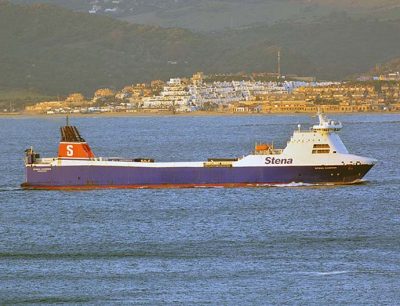

Elsewhere on the Stena network, the elderly 13,294gt/1982 built Stena Gothica repositioned to Hoek van Holland in March to cover for the 13,017gt/1996 built Stena Scotia which had been off service at Europoort since 27th February. Following refit, the 27,522gt/2006 built Rosslare-Cherbourg vessel Stena Horizon deputised for the Stena Adventurer on the Dublin-Holyhead route 6th-20th March whilst the latter was at A&P Falmouth for overhaul. Freight capacity was further boosted by the charter of the ubiquitous 7,606gt/1998 built and 65 trailer capacity Arrow to operate an 0600 from Dublin Mon-Sat before laying over in Holyhead and sailing back at night. The Stena Horizon’s place was taken on the Cherbourg route by the 21,171gt/2004 built Stena Carrier (above).
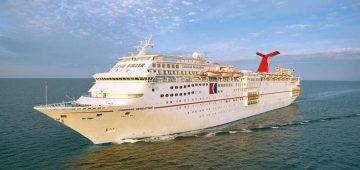



Comments
Sorry, comments are closed for this item